Standarts
или"The ideal Curl"Lisa Aring, Sarcenet Cattery (Texas, USA)Sarcenet (Техас, США)
On this page I'm going to attempt to explain the "ideal" Curl in layman's terms. For the specific standards, see the TICA and CFA American Curl standards.
Being a newer breed, there are still some differences of opinion on just what the ideal Curl should be. Fortunately it seems these differences are starting to lessen, but I'll note them (at least the ones I know of) herein.
Body, head and boning
The American Curl should be a long, slender, medium boned cat. Their body should be 1 and 1/2 times longer than tall, measuring height from the front foot to the top of the shoulder. They are described as "medium", although that is rather a relative term. Compared to many domestic cats, they are relatively petite both in size (females from 5-7 lbs and males from 7-10) and "feel".
Some people feel that the Curl should be larger than this, and in fairness the Standards do say that proper conformation is more important than overall size. This is a small point of contention among some breeders and in my opinion a bit of a contradiction in the Standard. Personally, I feel we should all breed towards the weight indications given, and only consider showing a larger sized cat if it were a fine example of the breed.
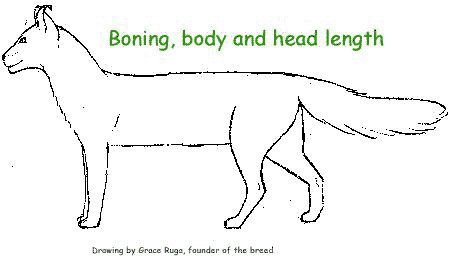
Curl tails should be in proportion to their body, ideally as long as the body. I.e., if you pull the tail alongside the body towards the head, it should reach the cat's shoulder. In the picture here the cat's tail is too short for the body. The reason is simply because they ran out of room on the piece of paper used to make the drawing.
While not in all of the Standards, the general breeder opinion tends to coincide in believing that head length should also be 1 and 1/2 times longer than wide. This is not nearly as extreme as it sounds and most Curls being shown today do have that head length. This is measured when looking down at the head: the widest point is usually right in front of the ears, and length is from the tip of the nose to the back of the top of the head.
Coat and Colors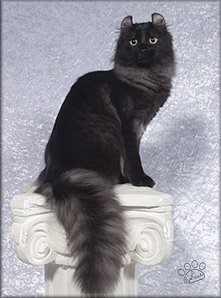
Curls are accepted in all colors, with the only limitation being that pointed cats must have blue eyes. At this point, we're still "building the barn" (trying to set body type), so color is unimportant. For that same reason, lockets and buttons (spots on the throat and belly) are not penalized, although of course if two cats are of equal quality, one would choose the one without lockets or buttons for breeding.
Coat texture is a bit more of a dilemma at this point. The Standards call for "minimal undercoat" and a "flat-laying coat". Some breeders and judges interpret this to mean that a minimal undercoat is allowed, but that the goal should be to reach no undercoat. Others feel that a minimal undercoat is called for. At this point, I would venture to say that whatever is being bred for, breeders coincide that the coat should not be "painted on" but rather always have a bit of spring or bounce to it.
Profiles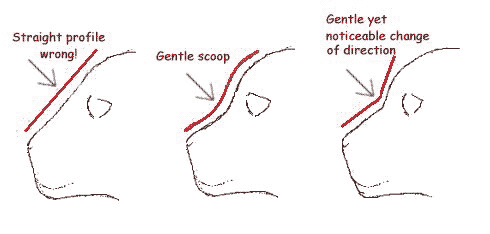
Here we also have two schools of thought. Everyone agrees that the profile
should NOT be straight, nor should it have a pronounced "break", like a Persian has. However, whether the ideal Curl profile should have a smooth "scoop" or more of a noticeable change of direction is still a
topic for discussion. I've tried to represent the different types of profiles here - but must apologize as I'm not the best with graphics!
Head balance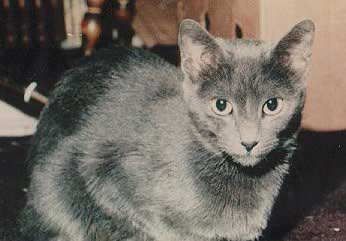 Left is a picture of Vashti of Curlniques, considered by many to be an ideal domestic outcross for the breed. Notice that her head is about 1 and 1/2 times longer than wide. This type of head is known as a modified wedge, an elongated triangle. She also has smooth transitions, i.e. the sides of her face do not pinch in behind the whiskers, but rather form a smooth straight line reaching towards the back and top of her head.
You may have seen rounder-headed American Curls from the earlier years, when breeders were still working to pull the breed together. It appears that now most breeders are aiming for a longer, smoother head - although Vashti's head length may be considered a bit extreme (too long) by some breeders.
Eye shape and placement |
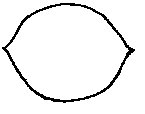
| Curl eyes are known as "walnut shaped". They should be midway between the nose and the ear and slanted upwards towards the outer edge of the ear. An ideal Curl should have a head with three equal "thirds": one third from the nose to the center of the eye, the second from the eye to the outer base of the ear, and the third being the ears themselves. I've tried to show what I mean in the picture to the left.
|
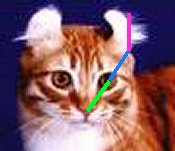 |
Ears
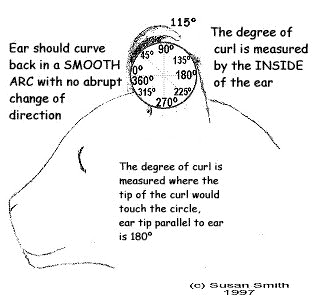 The ears of a show quality Curl should have a curl of 90є to 180є degrees. Depending on the curl of the ear, there are three "degrees" of curl: 1st, 2nd and 3rd - with 3rd being considered show quality. It is however important to realize that a show quality cat must have a lot more than simply good ears - ears account for only 30% or less of the total 100 points in the Standards. It is also very important to remember that a tighter curl does not mean a better show Curl. They need to have at least the minimum degree of curl specified, but overall ear shape and placement and the overall cat (the other 60% or more of the standard) carries a much greater weight than degree of curl.
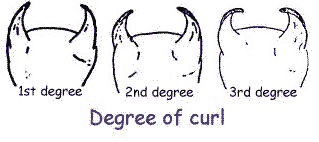 If the tip touches the back of the ear, this is too extreme and penalized. The bases of the ear should be wide, but should NOT have an "inside-out" look, this is a fault known as horizontal crimp. There are many facets to the curled ear. I'm adding information on ear faults, in the meantime for more detailed information - including diagrams and pictures - I recommend the following two sites: Some of the faults discussed below are clearly penalized in the standards. Others are deviations from the "ideal" or "perfect" curled ear. And as all breeders know, perfection is hard to achieve!
I must mention that ear faults in American Curls are aesthetic only and do not indicate health problems or problems with the ear.
Ears defects: Horisontal crimp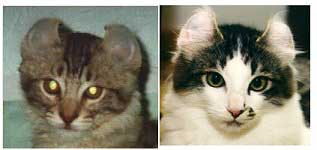
The two cats pictured to the right display what is known as Horizontal Crimp, which can be defined as: Excessive width of both edges of the base of the ear distinguished by the ear continuing beyond a vertical curved ridge that one would have expected to be the natural outer edges of the ear, giving the ear a splayed appearance (splayed: spreading outward, broad and flat). A horizontal ridge of cartilage is also visible in the center of the ear above the canal.
Ears defects: Vertical crimp, Rippling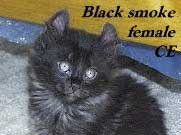 This isn't the best picture unfortunately, but this kitten displays two ear faults. First, if you look closely you can see that her ears have a rippled or corrugated appearance to them. Curled ears should be smooth, except for the normal convulations at the base inside all cats' ears.
Vertical Crimp can be defined as: Beginning at the base of the ear and continuing along some or all of its height, the outer edge of the ear bends or rolls vertically in toward the center of the ear giving the outer edge of the ear a pinched or crimped aspect.
Vertical crimp will often "straighten" the ear, although by no means are all 1st or 2nd degree curls caused by this fault - it's usually just naturally a looser curl.
Ear faults: A comparison, Vertical Crimp vs Horizontal Crimp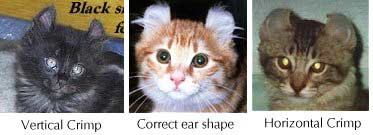
In short, vertical and horizontal crimp are two opposite and undesirable extremes affecting the base of the curled ear. The former causes the base to appear too narrow, the latter causes the base to appear too wide.
Ear faults: Small ear base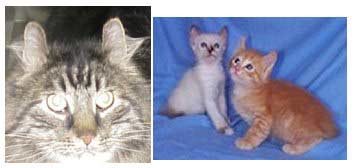 The cats pictured here are both 1st or 0 degree Curls, i.e. they aren't "straight-eared" or normal eared, but rather have the hard cartilage found in curled ears. The problem here is not the lack of curl - which is not that unusual to get - but the small size of the ears and ear base of the brown tabby. The kittens pictured are also 1st or 0 degree, but maintain the wider ear base we like to see (although their ears are somewhat low set on the head).
Ear faults: Abrupt change of direction

What we're looking at here is an "abrupt change of direction rather than a smooth curve". The cat on the left has what is sometimes described as an "upside-down "U" type ear". (It's ears are also too small). The cat on the right has a "flat top" ear, with more of a 90 degree angle than a nice smooth curve. Compare them to the kitten in the middle who maintains a smooth curve despite having *very* tightly curled ears.
Having said all this, please remember that this is what we're looking for in a Show Cat. If what you want is a loving pet, you'll still get the best thing about Curls - their fantastic personalities - whether they're show quality or not. I truly believe that every Curl is a work of art. Some of my most beautiful cats were not suitable for the showhall, but were lovely, loving companions sure to delight every pet owner and bring joy to their lives.
|
 ENGLISH
ENGLISH  ENGLISH
ENGLISH